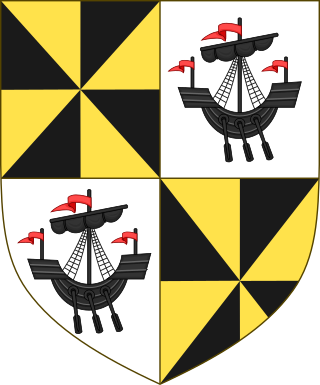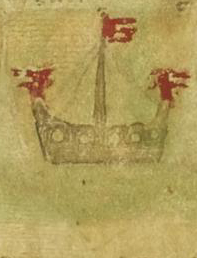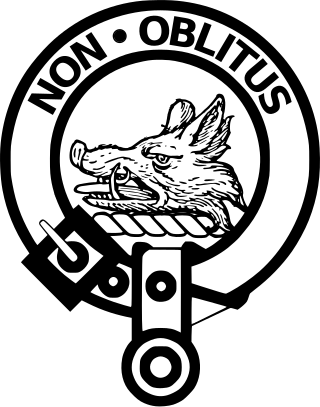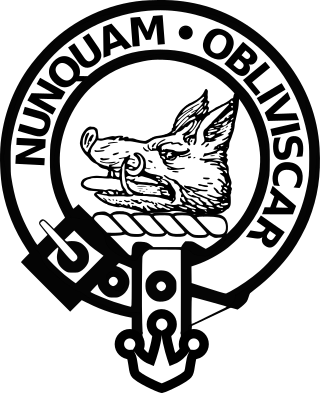Related Research Articles

Clan Campbell is a Highland Scottish clan, historically one of the largest and most powerful of the Highland clans. The Clan Campbell lands are in Argyll and within their lands lies Ben Cruachan. The chief of the clan became Earl of Argyll and later Duke of Argyll.

Duke of Argyll is a title created in the peerage of Scotland in 1701 and in the peerage of the United Kingdom in 1892. The earls, marquesses, and dukes of Argyll were for several centuries among the most powerful noble families in Scotland. As such, they played a major role in Scottish history throughout the 16th, 17th, and 18th centuries. The Duke of Argyll also holds the hereditary titles of chief of Clan Campbell and Master of the Household of Scotland.

Colin Campbell, 1st Earl of Argyll was a medieval Scottish nobleman, peer, and politician. He was the son of Archibald Campbell, Master of Campbell and Elizabeth Somerville, daughter of John Somerville, 3rd Lord Somerville. He had the sobriquet Colin Mulle, Bold Earl Colin.

Gillespie Archibald Campbell, 2nd Earl of Argyll was a Scottish nobleman and politician who was killed at the Battle of Flodden.

The sovereign or feudal lordship of Argyle was the holding of the senior branch of descendants of Somerled (Somhairle), this branch becoming soon known as Clan MacDougall

Clan MacDougall is a Highland Scottish clan, historically based in and around Argyll. The Lord Lyon King of Arms, the Scottish official with responsibility for regulating heraldry in Scotland, issuing new grants of coats of arms, and serving as the judge of the Court of the Lord Lyon, recognizes under Scottish law the Chief of Clan MacDougall. The MacDougall chiefs share a common ancestry with the chiefs of Clan Donald in descent from Somerled of the 12th century. In the 13th century the Clan MacDougall whose chiefs were the original Lords of Argyll and later Lords of Lorne was the most powerful clan in the Western Highlands. During the Wars of Scottish Independence the MacDougalls sided with the Clan Comyn whose chiefs rivaled Robert the Bruce for the Scottish Crown and this resulted in clan battles between the MacDougalls and Bruce. This marked the MacDougall's fall from power and led to the rise of their relatives, the Clan Donald, who had supported Bruce and also the rise to power of the Clan Campbell who were then the habitual enemies of the MacDougalls and later of Clan Donald.

The Campbells of Craignish form one of the oldest branches of the ancient and powerful Clan Campbell in Scotland. They claim descent from Dugald Campbell, the second son of Sir Archibald Gillespic Campbell (b.1130), 5th Knight of Lochawe and 20th Chief of Clan Campbell at the time. Sir Archibald's first son, Sir Duncan Campbell, 6th Knight of Lochawe, was the founder of the principal branch of the Campbell family who today holds the title Duke of Argyll.
Cailean Mór Caimbeul is one of the earliest attested members of Clan Campbell and an important ancestor figure of the later medieval Earls of Argyll.
Sir Niall mac Cailein, also known as Neil Campbell or Nigel Campbell, was a nobleman and warrior who spent his life in the service of King Robert I of Scotland, His Gaelic name means "Niall, Colin's son" since he was the son of Cailean Mór. His services to the King elevated the Campbells into the higher ranks of the Scottish nobility.

Clan MacTavish is an Ancient Highland Scottish clan with Irish origins.

Clan MacIver or Clan MacIvor, also known as Clan Iver, is a Scottish clan recognised by the Lord Lyon King of Arms. The clan, however, does not have a chief recognised by the Lord Lyon King of Arms. Because of this the clan can be considered an armigerous clan. The clan name of MacIver is of Gaelic origin, derived from an Old Norse personal name. Various forms of the surname MacIver, like MacGiver, are considered sept names of several historically large Scottish clans, such as clans Campbell and Mackenzie. There exists a Clan Iver society in Fife, Scotland.

Clan MacEwen or Clan MacEwan is a Scottish clan recorded in the fifteenth century as Clan Ewen of Otter.

Duncan Campbell, 1st Lord Campbell (Classical Gaelic Donnchadh mac Cailein, and also called Donnchadh na-Adh of Loch Awe,, was a Scottish nobleman and politician. He was an important figure in Scottish affairs in the first half of the 15th century and Justiciar of Argyll. He was head of the Clan Campbell for 40 years.
William Graham, 3rd Earl of Menteith was a Scottish magnate and third Earl of Menteith.

The Campbell of Auchinbreck family was founded by Duncan Campbell in Glassary, Argyll, Scotland. He was the son of Lord Duncan Campbell, first Lord Campbell of the Clan Campbell, by his second wife Margaret, daughter of Sir John Stewart of Blackhall, the illegitimate son of King Robert III of Scotland. The family of the Lords Campbell later became Dukes of Argyll, and remain chiefs of Clan Campbell. Duncan Campbell, as a grandson of King Robert III, received a considerable estate confirmed by royal charter dated 19 June 1452. The family remained at their estate of Auchinbreck, from which they took their title, until 1641. The Campbells of Auchinbreck were commissioned to provide military training and were used by the Earls of Argyll as military support. In 1628 the then head of the family of Campbells in Auchinbreck received a baronetcy, which included a grant of North American land in Nova Scotia.
John Gallda MacDougall, Lord of Lorne, also known as John MacDougall, and John Macdougall, and in Gaelic as Eoin MacDubhghaill, Eoin Gallda MacDubhghaill, Eòin Gallda MacDubhghaill, and Eóin Gallda Mac Dubhghaill, was a fourteenth-century Scottish magnate. He was a grandson of John MacDougall, Lord of Argyll, a man who had been forced from Scotland into exile in the first third of the century. It was under John Gallda that the MacDougall leadership made its resurgence in Scotland after generations of English exile.
The Sheriff of Argyll was historically a royal officer charged with enforcing the king's rights in Argyll; in Scotland, the concept of sheriff gradually evolved into a judicial position.

The Battle of Red Ford or Battle of the String of Lorne took place in 1294 or else after September 1296 between Clan Campbell and Clan MacDougall in Lorne, Scotland. The battle was fought over disputed lands. It ended in defeat of the Clan Campbell of Lochawe. The battle was on the borders of Loch Awe and Lorne, with the site and battle named Red Ford after the ford which ran red with blood where the battle took place.

Suibhne mac Duinnshléibhe was a late 12th-century, and early 13th-century, lord in Argyll. He does not appear in contemporary records, although his name appears in the patronymic names of two of his sons. Suibhne appears in the 16th century Leabhar Chlainne Suibhne, which documents the early history of Clann Suibhne. This account claims that he is the ancestor of Irish clan, and that he was the builder of Castle Sween in Knapdale, Argyll. However, other sources suggest the castle was built in the late 11th century by Suibhne MacAnrahan, brother of the High King of Ireland. Suibhne is said to be identical to the "Swineruo", or Suibhne Ruadh, recorded in the Ane Accompt of the Genealogie of the Campbells, a 17th-century Clan Campbell genealogy.
Sir Colin Og Campbell of Lochawe, also known as Cailean Óg Caimbeul, Sir Colyn Cambel, Colin the Young, and Coline Oig Campbell, was an early member of Clan Campbell and patrilineal ancestor of the Earls of Argyll. He was lord of Lochawe and Ardscotnish from 1316 until his death sometime before 1343.
References
- ↑ Campbell of Airds 2000, p. xviii-xix.
- 1 2 Campbell of Airds 2000, p. 83.
- 1 2 MacPhail 1916, p. 91.
- ↑ Campbell of Airds 2000, p. 99.
- ↑ Campbell of Airds 2000, p. 92-93.
- ↑ Campbell of Airds 2000, p. 96.
- ↑ Campbell of Airds 2000, p. 95-96.
- ↑ Collins 1741, p. 439.
- 1 2 3 Campbell of Airds 2000, p. 100.